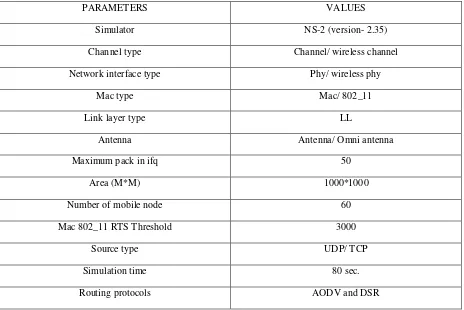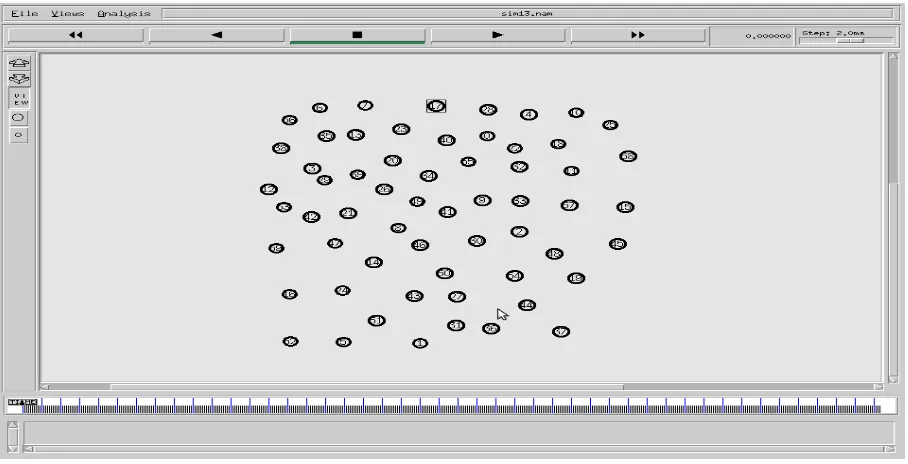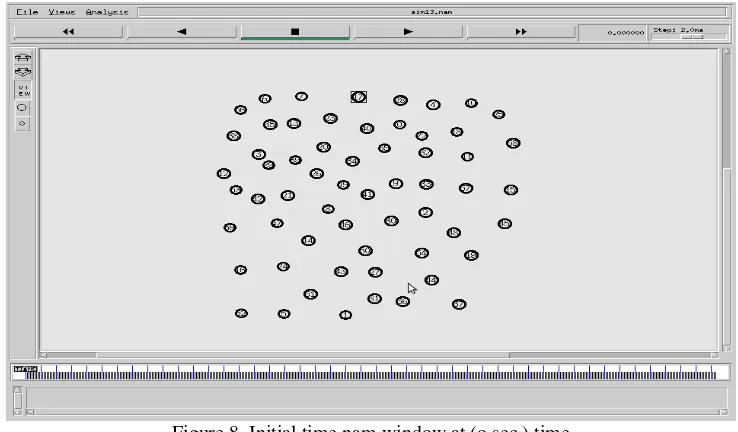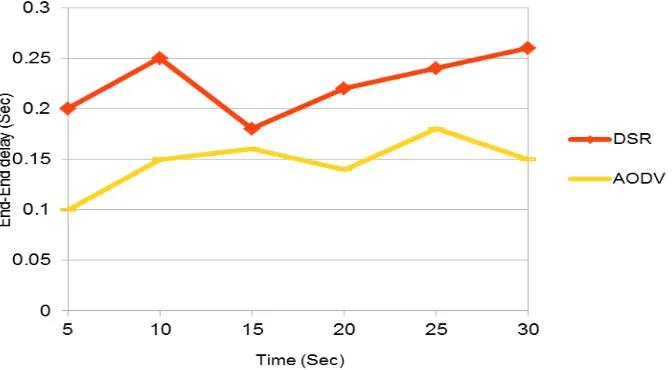Performance Analysis of Ad-hoc on Demand Distance Vector
Routing (AODV) and Dynamic Source Routing (DSR) routing
Protocols for Mobile Ad-hoc Networks
Bhushan Ramesh Ratnaparakhi
1,Prof. Ranjana R. Gite
2,Prof.
Dattatray S. Babe
31 Student of Dept. of Electronics and Telecommunications , Vidyalankar Institute of Technology Mumbai 2
Assistant Professor Dept. of Electronics and Telecommunications , Vidyalankar Institute of Technology Mumbai
3 Assistant Professor Dept. of Electronics and Telecommunications, Vidyalankar Institute of Technology
Mumbai
I. INTRODUCTION
A Mobile Ad hoc Networks (MANETs) is a collection of mobile devices that can communicate with each other without the use of a predefined infrastructure or centralized administration [1]. Mobile Ad hoc Networks are new generation of networks offering unrestricted mobility without any underlying infrastructure [1-2]. A mobile Ad hoc network is a dynamically self-organizing network without any central administrator or infrastructure support. It is composed of mobile terminals and that communicates with one to other and broadcast through radio transmission. In ad hoc wireless networks, communicating data is vulnerable to lots of potential attacks due to their characteristics of having dynamic topology, limited bandwidth and energy constraints [1-4].
ABSTRACT
Mobile Ad hoc Networks are the new generation of networks which offers unrestricted mobility without fail of any underlying infrastructure. In ad hoc wireless networks, communicating data is vulnerable to lots of potential attacks due to their unique characteristics of having dynamic topology, limited bandwidth and energy constraints in the protocols [1-4]. In addition to that freedom of mobility, a MANET can be constructed quickly at a low cost, as it does not rely on existing network infrastructure. Due to this flexibility, a MANET is attractive for applications such as emergency operations, vehicle networks, disaster relief, military service, casual meetings, campus networks, maritime communications, robot networks, and so on. Dynamic topology, limited bandwidth and energy constraints this are the negative points of this network [1-3]. Routing protocols are mainly classified in reactive and proactive routing protocols. In reactive routing protocols, such as the Ad hoc On Demand Distance Vector (AODV) protocol nodes find routes only when required and Dynamic Source Routing (DSR) is also an on-demand protocol and features similar route discovery as AODV [6]. A source route is appended to all packets and intermediate nodes only when use this source route to forward data. Scope of this project is based on mentioned routing protocols.
1.2 Approach of network
This infrastructure network made up of networks with wired and fixed gateways. A mobile host communication with a bridge in network primarily called base station available within communication radius. This area of infrastructure network defined in program. The mobile unit that is node can move random geographically while it is communicating. In this ad hoc network all nodes are mobile and can be connected dynamically in random manner. When mobile unit goes out of range of one base station then it connects automatically with new base station and start communicating and information exchange happened in between two nodes this information in the form of data packets. The nodes in network function like routers which found and maintain routes to other node. The node in mobile ad hoc network can be cell phone, laptop, PDA and any device to capable of do communication. This is the overview of our Mobile Ad hoc Networks (MANETs).
1.3 Classification of MANETs Routing Protocols
The routing protocols of MANETs can be classified in three main types. Figure 1 shows diagrammatical classification of MANETs along with some relative examples routing protocols.
Routing protocols mainly classified in two types such as reactive and proactive routing protocols. In reactive routing protocol, the Ad hoc On Demand Distance Vector (AODV) protocol nodes find routes only when required and Dynamic Source Routing (DSR) is also an on-demand protocol and features similar route discovery as AODV. A source route is appended to all packets and intermediate nodes, and it uses this source route to forward data. In proactive routing protocols Optimized Link State Routing (OLSR) protocol has come.
Figure 1. Classification of MANETs Routing protocols [5].
II. MAIN INTRODUCTION ABOUT AODV AND DSR ROUTING PROTOCOLS IN
MANETS
2.1 Ad Hoc on Demand Distance Vector Routing (AODV)
Mobile Ad hoc network is one of branch in wireless networks for mobile node. This mobile wireless network is very popular now a day due to its unique characteristics. Basically routing protocols mainly classified in two types such as reactive and proactive routing protocols. In reactive routing protocol, the Ad hoc On Demand Distance Vector (AODV) protocol nodes find routes only when required and features similar route discovery. A source route is appended to all packets and intermediate nodes, and it uses this source route to forward data. It is the most important routing protocol in mobile wireless networks. The Ad Hoc On-Demand Distance Vector routing protocol (AODV) is an improvement of the Destination-Sequenced Distance Vector routing protocol (DSDV) [5]. DSDV has its efficiency in creating smaller ad-hoc networks. This is the main important functioning of Ad Hoc On-Demand Distance Vector routing protocol (AODV) in MANETs.
Reactive protocols discover routes only when needed. When node wants to communicate with another node then it checks its existing information with destination route node. If this checking is positive then communication established between source and destination node and further data exchange is going to be happened. The RREQ request in (Figure 2) is from source to destination gives discovers the path towards destination. After sending RREQ packet request to destination then destination node send back the RREP packet request send back to source. These RREP packets decide the shortest routing path between sources to destination.
Figure 2. A RREQ Source to Destination path generation [5]
Figure 3. A RREP Packet send back to Source [5]
Advantages:
AODV tries to minimize the number of required broadcasts. It creates the routes on-demand basis.
Need lower delay for connection setup.
Destination sequence numbers are used to find the latest route to the destination.
Disadvantages:
Does not follow the unidirectional links.
Figure 4. AODV link notification [5].
2.2 Dynamic Source Routing (DSR)
These Dynamic Source Routing protocol come under reactive routing protocol in classification of routing techniques of mobile Ad hoc network. The Dynamic Source Routing (DSR) protocol is an on-demand routing protocol based on source routing. In the source routing technique, a sender determines the exact sequence of nodes through which to propagate a packet [5]. The list of intermediate nodes for routing is
explicitly contained in the packet’s header. DRS are a simple form and effective routing protocol design for use
of multi-hop wireless ad hoc networks of mobile nodes. It is type of self-organizing and self-configuring network.
Figure 5: DSR discovery route A source to E destination.
Advantages:
Self-organize Self-configuring Less End-to-End delay.
Disadvantages:
Only find path one node to other.
Path directory added to next upcoming path.
III. NETWORK SIMULATION ENVIRONMENTS
The Network simulator is a name for series of discrete event network simulators, specifically ns-1, ns-2 and ns-3. All of them are discrete-event network simulator. It is tool in which wireless networks simulation can be done due genuine limitations to high cost of implementation, area limitations, etc. In 1996-97, ns version 2 (ns-2) was initiated based on a refactoring by Steve McCanne. Use of Tcl was replaced by MIT's Object Tcl (OTcl), an object-oriented dialect Tcl [1]. The core of ns-2 is also written in C++, but the C++ simulation objects are linked to shadow objects in OTcl and variables can be linked between both language realms. Simulation scripts are written in the OTcl language, an extension of the Tcl scripting language [3-4].
3.1 Workflow for simulation
There is some general process of creating a simulation given in as per several steps. These steps are as follows:
Topology definition: to ease the creation of basic facilities and define their interrelationships, ns-2 has a system of containers and helpers that facilitates this process.
Model development: models are added to simulation (for example, UDP, IPv4, point to-point devices and links, applications); most of the time this is done using helpers.
Node and link configuration: models set their default values (for example, the size of packets sent by an application or MTU of a point-to-point link); most of the time this is done using the attribute system.
Execution: simulation facilities generate events, data requested by the user is logged.
Performance analysis: after the simulation is finished and data is available as a time stamped event trace. This data can then be statistically analysed with tools like R to draw conclusions.
Graphical Visualization: raw or processed data collected in a simulation can be graphed using tools like Gnuplot, matplotlib or XGRAPH [5].
3.2 Strategy for simulation work
For the simulation purpose latest version 2.35 of NS-2 has been used in this project work. This setup is done on the windows operating system, for do this work we have to install Oracle VM virtual box on windows 7 computer. Then Oracle VM virtual box gives the platform of LINUX operating system to run Ubuntu 12.04 (32 bit) in this virtual system to do actual simulation of project operation NS-2 network simulating software.
3.2.1 Scenario
Topology of 1000*1000 is taken for simulation. Nodes are moving at constant random speed.
Nodes are being generated randomly at random position.
Nodes are generated at random time as if few nodes are entering into the topology. Radio propagation model used is Two-Ray Ground.
Movement is linear and node speed is constant for a simulation. Antenna model used is Omni Antenna.
The simulation parameters are listed in Table.
3.2.3 Performance matrix
The following different performance matrices are evaluated the behavior of AODV, DSR routing protocols wireless network of mobile ad hoc networks MANETs. For this work some parameters are taken into consideration.
Routing Overhead.
Throughput.
Table 1. Simulation Parameters for NS-2.
The objective of this project is the performance evaluation of two routing protocol for mobile ad hoc networks by using an open-source network simulation tool called NS-2. Two routing protocols: AODV, DSR have been considered for performance evaluation in this work. The simulation environment has been conducted with the LINUX operating system, because NS-2 works with Linux platform only. This gives the overview related to project.
Figure 6. Simulation overview [5]
Whole simulation study is divided into two parts; one is create the node that may be cell phone, internet or any other devices. NS-2 output window is called NAM (Network Animator) file, which shows the node movement and communication occurs between various nodes in various conditions or to allow the users to visually appreciate the movement as well as the interactions of the mobile nodes. And another one is graphical analysis of trace file (.tr). Trace files contain the traces of event that can be further processed to understand the performance of the network.
A software program which can shorten the process of parsing trace files (Xgraph and TraceGraph) has also been used in this project. However, it doesn’t work well when the trace file is too large. To generate trace file and nam file, we call tcl script in CYGWIN command shell. By varying the simulation parameter shown in table 1, we can see the graphical variation between various performance metrics like Routing Overhead, End-to-End Delay with node speed and Throughput etc.
3.4 Nam file
NAM is a Tcl/TK based animation tool for viewing network simulation traces and real world packet traces. A network animator that provides packet-level animation and protocol-specific graphs to aid the design and debugging of new network protocols have been described. Taking data from network simulators such as ns or live networks, NAM was one of the first tools to provide general purpose, packet-level, and network animation, before starting to use NAM, a trace file needs to create [7]. This trace file is usually generated by NS. Once the trace file is generated, NAM can be used to animate it. A snapshot of the simulation topology in NAM for 60 mobile nodes is shown in figure 7 which is visualized the traces of communication or packets movements between mobile nodes.
Figure 7. Nam window snapshot for mobile nodes.
4. Actual project NAM windows in project
Following various Nam windows are taken from run time of project with some time interval to show the working of node on that time period. These images are gives the actual field simulation happened at that time. Nam window shows original view of run time project on screen with node activity. This Nam window is user define, space is created accordingly in object program file. In this project proj.tcl is program file.
Below table give some indications related to colours and diagrams available in simulation window.
Table 2. Indicative parameter for simulating nam window in NS-2
Sr. no Parameters Indication to images
1 Number in circle Node
2 Node in green circle Source node
3 Node in red circle Destination node
4 Black dotted lines Packet transmission between nodes
This figure 8 shows the initial image of NAM window at time 0 sec.
Figure 8. Initial time nam window at (o sec.) time
This figure 9 shows the image of NAM window at time 10 sec.
Figure 9. Nam window with (10 sec.) time
This figure 10 image shows at time of 21 sec interval.
Figure 11 at interval of 32 sec. shows the last NAM window which shows all packet data transmission and packet losses in the actual scenario.
Figure 11. Nam window at (32 sec.) time
V. RESULTING GRAPH OF PROJECT
Below graphs are created from actual output data obtained in run time simulation. This output data can be converted in various graphs for observation made by using Microsoft excel Tool in windows.
Routing Overhead- Routing Overhead is one of the performance parameter which gives the analytical study of routing protocols by using such parameters we can able to tell which on is good. Basically Routing Protocol is the performance parameter to find the best shortest routing path in between two consecutive nodes. High value graph shows the better performance and gives the best routing overhead.
Figure 12. Routing Overhead Vs Time (Sec.)
Figure 13: Throughput vs. Time (Sec.)
End-to-End Delay- In which specific packet is transmitting from source node to destination node and calculating the difference between send time and received time is called End-to-End Delay. Many factors like route discovery, queening propagation and transfer time gives the performance of delay. In this case if value with lower reading graph shows better End-to-End delay and this routing protocol is good.
Figure 14. End-to-End delay Vs Time
VI. CONCLUSION
Conclusion of this project is based on the graphs which are obtained in actual run time simulation. Simulation did in Network Simulator (NS-2) specifically in network simulator 2.35 versions. Figure 12 shows the output graph of Routing Overhead as graph of higher value give the better routing protocol among the two, in this case AODV is superior according to definition of routing protocol which mentioned above. As per the definition of Throughput mentioned above higher value reading in Figure 13 which is DSR is the superior at the time of throughput part. As per the End-to-End delay concept Figure 14 give the clear indication that AODV has
VII. ACKNOWLWDGEMENTS
Authors like to do special thanks to Electronics and Telecommunication Engineering Department, Vidyalankar Institute of Technology, Mumbai University, India for providing appropriate information and related stuff. This work is accomplished and is successfully brought into existence due to the guidance and thorough attention of my guides Prof. Dattatray S. Bade sir and Prof. Ranjana R. Gite madam. I also wanted to do special thanks to my co-guide Prof. Ranjana R. Gite (Assistant Professor in Department of Electronics and Telecommunication, Vidyalankar Institute of Technology) for giving me her valuable time and co-operation. I would like to give a special thanks to my both guides to giving me a best opportunity to do a project work in area like Mobile Ad-hoc Networking. Kindly thanks to all staff members of Electronics and Telecommunication Department, my classmates for giving me there time and support for various problems and college authorities of Vidyalankar Institute of Technology.
REFERENCES
[1] Zeyad M Alfawaer, Saleem Al zoubi, “A proposed security subsystem for Ad hoc Wireless Networks”, International forum on Computer Science Technology and Application, June 2009.
[2] Yih-Chun Hu, David B. Johnson and Adrian Perrig, "SEAD: Secure Efficient Distance Vector Routing for Mobile Wireless Ad
hoc Networks", In Fourth IEEE Workshop on Mobile Computing Systems and Applications (WMCSA '02), June 2002, pp. 3-13, June 2002.
[3] Yih-Chun Hu, Adrian Perrig and David B. Johnson, "Ariadne: A Secure on Demand Routing Protocol for Ad-hoc Networks", in
Proceedings of the 8th annual international conference on Mobile computing and networking (MobiCom) '02, September 23-26, 2002, Atlanta, Georgia, USA.
[4] Panagiotis, Papadimitratos and Zygmunt J. Haas, "Secure Routing for Mobile Ad hoc Networks", In Proc. SCS Communication
Networks and Distributed Systems Modeling and Simulation Conference(CNDS2002), San Antonio, TX, January 27-3 1, 2002. [5] S.k. Gupta and R.k. saket, “Performance matric comparison of AODV AND DSDR routing protocols in MANETs using NS2”,
proceeding in volume 7, issue 3, IJRRAS, June 2011.
[6] S. Ci et al., “Self-Regulating Network Utilization in Mobile Ad-Hoc Wireless Networks,” IEEE Trans. Vehic. Tech., vol. 55, no.
4, July 2006, pp. 1302–10.
[7] B. Wu et al, “A Survey of Attacks and Countermeasures in Mobile Ad Hoc Networks,” Wireless/Mobile Network Security,
Springer, vol. 17, 2006.
[8] M. Zapata and N. Asokan, “Securing Ad Hoc Routing Protocols”, ACM Wise, 2002.
[9] P. Yi et al., “A New Routing Attack in Mobile Ad Hoc Networks,” Int’l. J. Info. Tech., vol. 11, no. 2, 2005.
[10] L. Buttyan and J.P Hubaux, “Stimulating cooperation in self-organizing mobile ad hoc networks”, ACM/Kluwer Mobile
![Figure 1. Classification of MANETs Routing protocols [5].](https://thumb-ap.123doks.com/thumbv2/123dok/2091647.1607379/2.595.97.502.497.671/figure-classification-manets-routing-protocols.webp)
![Figure 2. A RREQ Source to Destination path generation [5]](https://thumb-ap.123doks.com/thumbv2/123dok/2091647.1607379/3.595.192.406.479.580/figure-rreq-source-destination-path-generation.webp)
![Figure 4. AODV link notification [5].](https://thumb-ap.123doks.com/thumbv2/123dok/2091647.1607379/4.595.148.457.404.466/figure-aodv-link-notification.webp)




